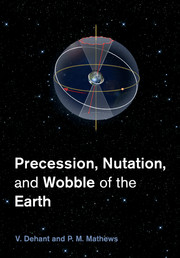Book contents
- Frontmatter
- Contents
- Preface
- List of abbreviations
- 1 Introduction – Fundamental definitions – Motivation
- 2 Concepts and elementary theory
- 3 Reference systems and frames
- 4 Observational techniques – ephemerides
- 5 Rigid Earth precession and nutation
- 6 Deformable Earth – Love numbers
- 7 Nutations of a non-rigid Earth
- 8 Anelasticity
- 9 Ocean and atmospheric corrections
- 10 Refinements of non-rigid nutation
- 11 Comparison observation-theory
- 12 Conventions
- 13 Mars nutations
- Appendix A Rotation representation
- Appendix B Clairaut theory
- Appendix C Definitions of equinoxes
- Bibliography
- Index
12 - Conventions
Published online by Cambridge University Press: 05 May 2015
- Frontmatter
- Contents
- Preface
- List of abbreviations
- 1 Introduction – Fundamental definitions – Motivation
- 2 Concepts and elementary theory
- 3 Reference systems and frames
- 4 Observational techniques – ephemerides
- 5 Rigid Earth precession and nutation
- 6 Deformable Earth – Love numbers
- 7 Nutations of a non-rigid Earth
- 8 Anelasticity
- 9 Ocean and atmospheric corrections
- 10 Refinements of non-rigid nutation
- 11 Comparison observation-theory
- 12 Conventions
- 13 Mars nutations
- Appendix A Rotation representation
- Appendix B Clairaut theory
- Appendix C Definitions of equinoxes
- Bibliography
- Index
Summary
This chapter has been written in order to explain to the reader the new concepts, in use from 1 January, 2003, for the precise definition of precession and nutation and other aspects of Earth rotation. More details, if desired, may be found in the references mentioned in the text. Additionally, the International Earth rotation and Reference system Service (IERS) has published the Conventions (IERS Conventions 2003, 2010) in which the new paradigm is given, as well as Technical notes (IERS TN 29) in which one finds articles on various aspects of the new paradigm by Capitaine, Capitaine et al., Fukushima, Guinot, Gontier, Kovalevsky, McCarthy and Capitaine, Seidelmann, and Wallace. Furthermore, other articles can also be found useful, such as those of Capitaine (1986), Capitaine and Guinot (1988), Capitaine et al., 2003a–d, 2005a and b, and Kaplan, 2003, 2005a, and b.
Definition of equator
As seen in Chapter 2 and Chapter 3 (see also Appendix C), the ecliptic is the plane of the orbit of the Earth–Moon barycenter around the Sun. It is the plane perpendicular to the mean orbital angular momentum vector of the Earth-Moon barycenter. It is a conceptual plane of which the realization depends on a specified epoch and a specified date. When not otherwise specified, the term “ecliptic” consists in the fixed ecliptic of J2000 and is referred to the celestial frame realized by coordinates of the radio sources of the ICRF by a set of fixed angles. The actual ecliptic plane undergoes a very slow motion (a very slow rotation mainly) in space as it is affected by planetary precession in longitude and obliquity.
Note that the ecliptic of the “inertial” system (space-fixed as defined in Section 2.22.1) is not the orbital plane of the Earth–Moon barycenter around the Sun, as the angular momentum vector of a particle orbiting a central mass in a moving (rotating) plane is not normal to that plane.
- Type
- Chapter
- Information
- Precession, Nutation and Wobble of the Earth , pp. 425 - 453Publisher: Cambridge University PressPrint publication year: 2015



